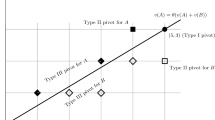Abstract
A model of majority rule is developed in which each of a finite number of generations votes on a redistribution of income between itself and the other generations. In voting, each generation expresses tastes for its own income and for the distribution of income across generations. The model is then used to derive the conditions under which discounting is justified — namely those conditions for which the majority rule exhibits a positive marginal rate of time preference. It is demonstrated that when each generation is wealthier than those preceding it, the parameters representing the taste for income equality must be relatively high for the majority rule to exhibit a positive marginal rate of time preference.
Similar content being viewed by others
References
Bailey, M.J. (1979). The discount rate in benefit cost analysis. University of Maryland: Department of Economics Working Paper 79-18.
Becker, R.A. (1982). Intergenerational equity: The capital-environment trade-off. Journal of Environmental Economics and Management 9 (2): 165–185.
Black, D. (1958). The theory of committees and elections. Cambridge: Cambridge University Press.
Brown, S.P.A. (1979). Public choice, intergenerational equity and the social rate of discount. University of Maryland: Ph.D. dissertation.
Hamada, K. (1973). A simple majority rule on the distribution of income. Journal of Economic Theory 6 (3): 243–264.
Marglin, S. (1963). The social rate of discount and the optimal rate of investment. The Quarterly Journal of Economics 77 (1): 95–111.
Page, T. (1977). Conservation and economic efficiency. Baltimore: Johns Hopkins University Press for Resources for the Future.
Pigou, A.C. (1932). The economics of welfare. London: Macmillan.
Ramsey, F.P. (1928). A mathematical theory of saving. Economic Journal 38 (152): 543–559.
Solow, R.M. (1974). Intergenerational equity and exhaustible resources. Review of Economic Studies Symposium: 29–45.
Thurow, L.C. (1971). The income distribution as a pure public good. Quarterly Journal of Economics 85 (2): 327–336.
Tullock, G. (1964). The social rate of discount and the optimal rate of investment: Comment. The Quarterly Journal of Economics 78 (2): 331–336.
Author information
Authors and Affiliations
Additional information
I thank Martin J. Bailey, Charles C. Brown, John K. Hill, William T. Long III, Martin C. McGuire, Gerald P. O'Driscoll Jr., Joe Oppenheimer, James E. Pearce and Eugenie D. Short for their valuable comments and suggestions. The views expressed are mine and do not necessarily reflect those of the Federal Reserve Bank of Dallas or the Federal Reserve System.
Rights and permissions
About this article
Cite this article
Brown, S.P.A. The fairness of discounting: A majority rule approach. Public Choice 55, 215–226 (1987). https://doi.org/10.1007/BF00124867
Issue Date:
DOI: https://doi.org/10.1007/BF00124867




